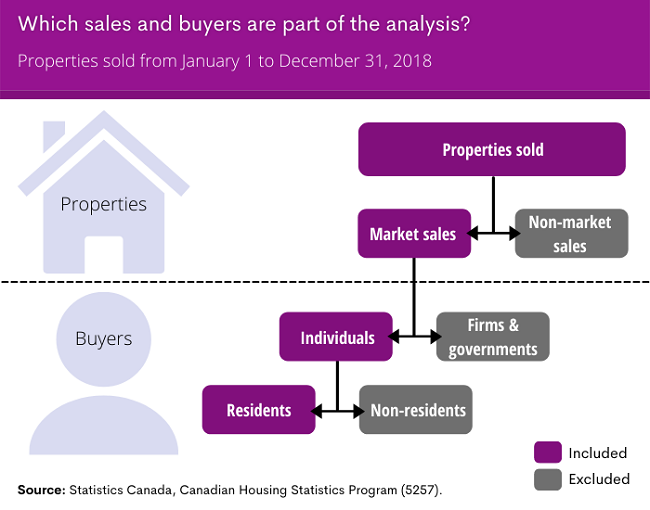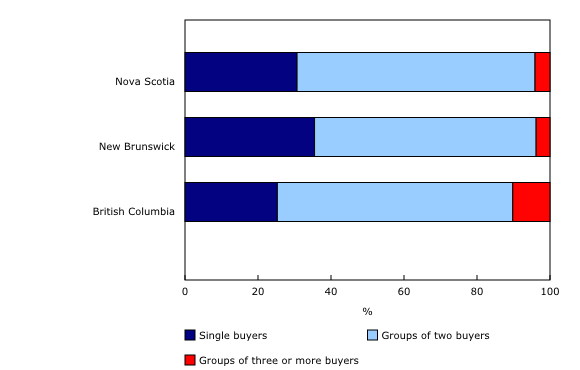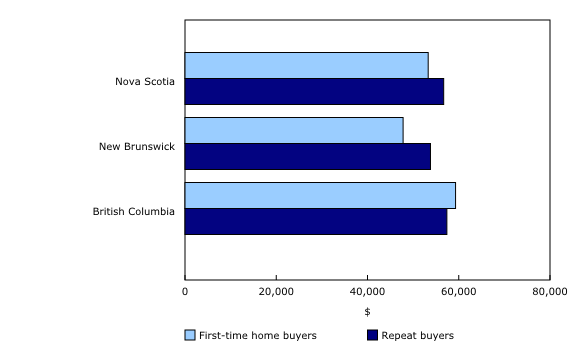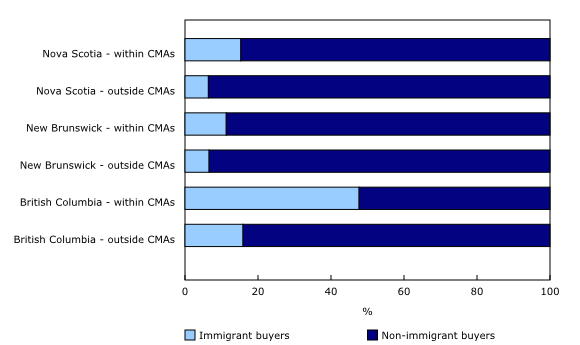Canadian Housing Statistics Program, Properties sold in 2018
Archived Content
Information identified as archived is provided for reference, research or recordkeeping purposes. It is not subject to the Government of Canada Web Standards and has not been altered or updated since it was archived. Please "contact us" to request a format other than those available.
Released: 2021-09-21
The article "Residential real estate sales in 2018: Who is purchasing real estate?," released today, is the second in a three-part series on residential real estate sales, published in Housing Statistics in Canada. This series offers new insights on the real estate market by examining the properties sold in Nova Scotia, New Brunswick and British Columbia from January 1 to December 31, 2018, and the characteristics of their buyers.
The analysis presents information on buyers, with a focus on income, first-time buyers and immigration status. This article will establish a solid basis for understanding the effects of the pandemic on the real estate sector.
British Columbia has the lowest share of single buyers and the largest share of buyers in groups
Most home buyers in the three provinces studied bought a home jointly with another person in 2018. Nearly two-thirds of home buyers in Nova Scotia (65.2%) and British Columbia (64.5%) bought their home with another person, compared with three-fifths of home buyers in New Brunswick (60.7%).
Over one-third of the home buyers in New Brunswick (35.5%) purchased their home alone, the highest rate among the provinces studied, while fewer than one in three home buyers in Nova Scotia (30.7%) and just over one in four in British Columbia (25.3%) bought their home alone.
In contrast, 10.2% of home buyers in British Columbia bought their home in groups of three or more, more than double the rates in Nova Scotia (4.1%) and New Brunswick (3.8%).
In Nova Scotia and New Brunswick, first-time home buyers earn less than repeat buyers
In 2018, just over one-fifth of buyers in Nova Scotia (22.2 %) and New Brunswick (22.4 %) claimed the home buyers' amount (HBA), a federal incentive program for first-time buyers, or purchased a property with an individual who claimed the HBA (referred to as "first-time home buyer" hereinafter). In contrast, the share of first-time home buyers was lower in British Columbia (15.2%).
First-time home buyers in Nova Scotia and British Columbia were more likely to purchase a property in a large urban centre, while those in New Brunswick were slightly more likely to buy a home in smaller cities or in a rural area.
In Nova Scotia, just over half (52.0%) of first-time home buyers purchased a property in Halifax, while in British Columbia, two-thirds (66.1%) of first-time home buyers purchased a property in a large urban centre.
The income of first-time home buyers and repeat buyers varied among the three provinces. In Nova Scotia and New Brunswick, first-time home buyers had lower incomes than repeat buyers. In contrast, the median income of first-time home buyers in British Columbia was 3.3% higher, compared with repeat buyers.
Immigrants mainly buy homes in larger urban areas
A larger share of immigrants purchased properties in 2018, compared with their overall share of the population in British Columbia, Nova Scotia and New Brunswick. For example, immigrants in Nova Scotia accounted for 10.1% of buyers, while accounting for 6.1% of the total population. In New Brunswick, 8.4% of home buyers were immigrants, compared with 4.6% of the total population.
British Columbia had the highest share of immigrant buyers, with over one-third of home buyers (35.2%) being immigrants, while accounting for 28.3% of the total population in the province.
Immigrants in all three provinces were more likely to buy a home in a large urban centre than in a smaller town or a rural setting. This was especially true in British Columbia, where 47.7% of all home buyers in large cities were immigrants, compared with 15.9% of all buyers outside census metropolitan areas.
A more detailed analysis on the characteristics of buyers, including the income of home buyers by sex and family type, and a comparative analysis of the sale price of properties purchased by immigrants and non-immigrants, is available in the article "Residential real estate sales in 2018: Who is purchasing real estate?".
Part one of the series, "Residential real estate sales in 2018: Characteristics of properties sold," provided an overview of the properties sold, including new information on the geographic distribution of sales, structure types, sale prices, and living areas.
Note to readers
The data used in this study are compiled from the Canadian Housing Statistics Program (CHSP). It includes properties sold from January 1 to December 31, 2018, which are linked to CHSP data for the reference year 2019. These data are integrated with the Longitudinal Immigration Database and the T1 Family File for tax year 2018.
The analysis in this article focuses on the buyers of properties sold in market sales, which involves unrelated and independent parties. Buyers of properties sold in non-market sales, such as sales by related parties, sales of special interest, sales of part-interest, forfeitures and foreclosures, are not included. The data are restricted to buyers who are individuals and who filed a T1 tax return form in 2018. Non-individual buyers (such as firms and governments) and non-resident buyers are not included. There may be more than one buyer per property. Buyers are counted for every property they purchased from January 1 to December 31, 2018, and are located in the province and census metropolitan area of the property or properties they purchased.
Claimants of the home buyers' amount (HBA) are individuals who claimed the amount ($5,000) in their federal income tax return form for the taxation year in which the home was acquired, or who purchased a property with an individual who claimed the amount. Previous CHSP releases identified HBA claimants only. As such, including those who purchased a property with at least one HBA claimant broadens the definition of first-time home buyers. According to the Canada Revenue Agency rules, the claimant and their spouse must not have lived in another home they owned during the preceding four years and must intend to occupy their new home within one year of purchasing it.
Geographical boundaries
The CHSP disseminates data based on the geographical boundaries from the Standard Geographical Classification 2016.
Definitions
Sale of property refers to whether a property had a transfer of ownership from one party to another party through a contractual agreement. A property is considered to have been sold on the date that the property was transferred to, recorded in, registered in or otherwise carried in the name of the party who purchased the property.
Market sale refers to an arm's length transaction where all parties act independently with no influence over the other.
Non-market sale refers to non-arm's length transactions, which includes distressed sales, foreclosures, trade and forfeitures, redemptions, sales of part interest, and special interest sales.
Property refers to land with legally defined boundaries and the constructions, works and improvements of a permanent nature located on, above or below its surface for which the rights to use and dispose can be assigned.
Total income includes income reported by tax filers from any of the following sources: employment income; dividends and interests; government transfers (including non-taxable income); private pensions; registered retirement savings plans; and other income such as net limited partnership income, rental net income, alimony, registered disability savings plans and other income (line 130 of the T1 form). It excludes veterans' disability and dependant pensioners' payments, war veterans' allowances, lottery winnings, and capital gains.
Contact information
For more information, contact us (toll-free 1-800-263-1136; 514-283-8300; STATCAN.infostats-infostats.STATCAN@canada.ca).
To enquire about the concepts, methods or data quality of this release, contact Jean-Philippe Deschamps-Laporte (343-998-7200; jean-philippe.deschamps-laporte@canada.ca).
- Date modified:





